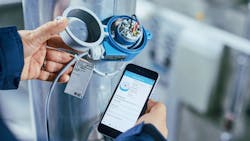The world continues to become more digitalized to such an extent that companies globally categorize it as essential rather than optional. That includes process automation industry experts, Endress+Hauser.
There are two main reasons for the push toward digitalization in the industrial sector: customer expectations and market forces. Endress+Hauser has not only taken notice of its customers’ digitalization needs and expectations, but also set forth on its own transformation.
The company’s digitalization journey began quite some time ago, mainly when the benefits of digitalization started to become very apparent not only in how the company’s products sent their variables and information to control and host systems, but also within its own ERP, CRM and service management systems. The journey’s results have helped make the company’s focus on end-to-end service and solutions even more possible.
“It has provided us a means to digitally connect our products to customers in a way that we never could before,” says Jason Pennington, director of digital solutions for Endress+Hauser.
Successful digital transformation
These days, instruments can create help desk tickets on their own. In addition, the devices can produce alarms and recommend possible remedies. They provide a secure means from a remote desktop into a device to help solve a customer’s challenge before they might even know they have one. These are just a few examples of the capability digitalization has brought to the table, according to Pennington.
As digitalization has flourished and the Industrial Internet of Things (IIoT) has emerged, three core areas of process control have seen the most changes. The first and most apparent involves what one can see and feel: miniaturization, power consumption, connectivity, HMIs and how people interact with devices.
ASICs were infused with microprocessors and pressure-to-current transducers became microprocessors and current-to-pressure transducers became 4-20mA transmitters. Meanwhile, a myriad of field buses emerged. Pennington says it’s been a pursuit to simplify, if not eliminate, wiring.
“So, combined with the idea of what more powerful microprocessors can support, our devices have evolved into process analysis tools for our customers that also happen to measure process variables,” he points out.
He adds that the evolution of multivariable measurement and bringing more quality aspects and diagnostics, in addition to the overall core measurement, have impacted the industrial sector.
Additionally, changes in the supply chain, particularly regarding sourcing “greener” and safer materials, whether for consumption or the good of the environment, have been just as impactful. For example, Endress+Hauser vetted its suppliers to be more inclusive, reputable and sustainable. As a result, it’s become part of the overall product picture. Another change is the growing importance of cybersecurity.
“It’s a very real thing for us today that maybe 25 years ago didn’t exist,” Pennington says of the importance of cybersecurity in an increasingly digital world.
Cybersecurity is part of how instruments and systems are now designed and built.
“It’s about digging down into the components as they become more connected in the world today,” he adds.
Journey and breakthroughs
One of the significant milestones in Endress+Hauser’s digital journey happened when the company connected its internal processes and production systems to benefit its customers.
Throughout every production step, from the time a piece arrives on the Greenwood campus, it’s scanned and logged. “We know who touched it, where it came from, how it got here and if it’s authentic.”
A QR code on each product helps digitize processes, allowing data-minded customers to get all the necessary information to check on reliability, build a Pareto analysis, or track alarm trends over time. Those are only some of the capabilities available to customers.
The process also guards against counterfeit parts.
There have been other breakthroughs in the digitalization journey for Endress+Hauser. Pennington points to flow as an area that has seen a digital evolution of products.
Over time, flow devices became more advanced on the power management front. In addition, the evolution of Safety by Design meant devices provided a safer environment, both electrically in hazardous areas and their operations.
In addition, printed circuit boards have allowed for the creation of traceable and highly reliable diagnostics.
End-user expectations
Manufacturers and representatives have an opportunity now with tools such as Heartbeat Technology® as well as other remote diagnostics, to support their end-users through the product lifecycle. Such support on an ongoing basis is another frontier in digitalization: moving from being connected to using connectivity to solve challenges or to advance business objectives.
“Sourcing data through this connectivity is the easy part. It’s how you do it and more importantly, what you do with it that matters,” Pennington says.
He points out that staying ahead of the evolution comes from dialog with customers. It helps create a broader enterprise view of some of the products. In fact, Endress+Hauser has been able to use Heartbeat Technology and Netilion Connect, an API platform, to provide customers the capability to create a calendar in their system and the devices know if they’re safety-important, safety-critical, fiscally-critical or regulatory. For devices that are not on the calendar within the customer system, they can have Netilion run Heartbeat verifications on the devices. When they pass verification, they’re able to produce a certificate with that ISO stamp and close the work order. Connected devices can have Netilion run Heartbeat verifications either by calendar scheduling or on-demand. This process delivers insightful information to the user but can also be automated to effectively perform its own maintenance and work order management. The ISO recognized verification results are stored within the Netilion Library and presented to the user.
The process lets customers autonomously maintain their systems, and if there’s a failure in the functionality of the verification, Endress+Hauser can provide diagnostics, remedies and even the spare parts information. Pennington says such systems represent the devices’ “connected spirit.”
Endress+Hauser and the entire industrial sector are continuing the digitalization journey. The more digitized the industry becomes, safely integrating data can help create more reliable, safe and efficient systems and processes.


